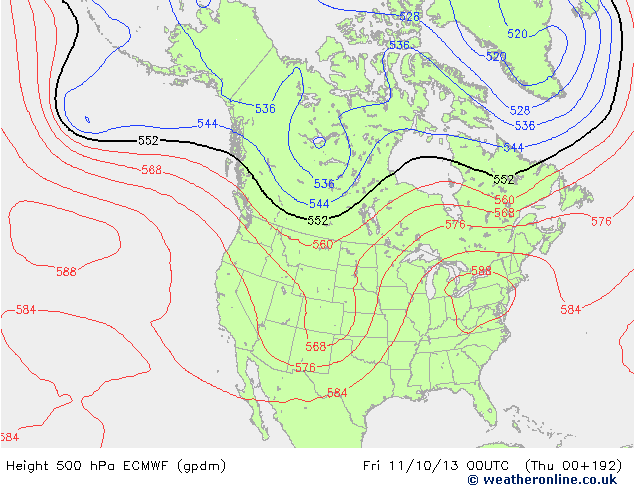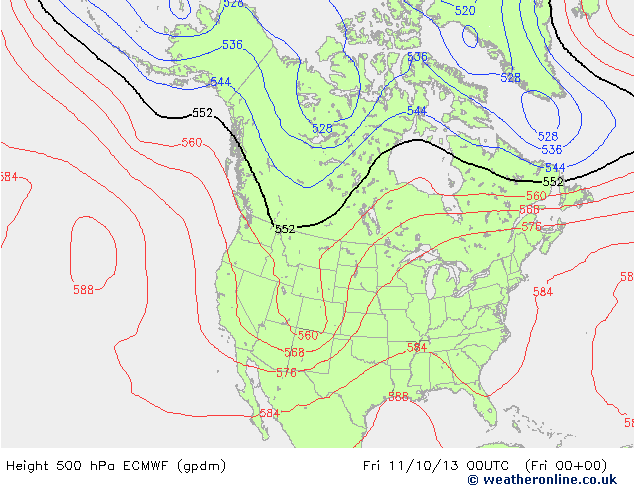One of the nice things about being able to interpret 500 mb height maps is that one can can easily visualize the large-scale weather patterns that are forecasted by computer-generated numerical weather prediction models. There are dozens of groups worldwide that run different numerical models for weather forecasting and hundreds of web sites that display this data. The fact that each model produces different forecasts indicates that there is uncertainty in making numerical weather forecasts. You probably realize from your own experiences that weather forecasts are not exact and can sometimes be way off. When different forecast models make different predictions of future weather, your local weather forecaster has to decide which to believe in making his personal forecast. Generally numerical weather forecast models in the winter season are quite accurate for 1-5 days into the future, somewhat less accurate for 6-9 days into the future, sometimes helpful for 10-12 day forecasts, and have little skill in forecasting more than 12 days into the future. We will cover material discussing limitations on the accuracy of numerical weather forecasting in later lectures.
On this page you will learn how to get numerical weather forecasts from two different sources and how to interpret the 500 mb height maps produced. We will also use maps from these sources for an extra credit assignment. Out of the numerous web pages containing numerical weather forecast information, a major reason for selecting the two sites below is that those sites allow the user to create forecast maps that show only the 500 mb height pattern. Most of the maps that are produced by other sites cram much more information (in addition to 500 mb heights) onto the plots, which can make it difficult for a beginner to concentrate on the 500 mb height pattern. If you become interested in looking at numerical weather forecast information, then I encourage you to visit other sites as well.
This site was mentioned on the introductory lecture page on 500 mb maps. Click on http://weather.uwyo.edu/models/ (link should open a new tab or browser window) and follow these instructions. You must first select a model. In class we will use either the GFS (Global Forecast System) or Medium Range Forecast (MRF) both run in the US by NOAA. You must fill in the drop-down menus and dots to select the maps you want to display. For now select the latest possible initial time (default value) and set the other items as shown below
If you are interested you can use this site to produce other forecast images. We will not have time to do much of this as part of the class, but feel free to explore and ask questions. One item that I sometimes choose to add to the 500 mb maps is to select precipitation as one of the color fills to see where and how much precipitation is forecast by the model.
This site will be used to get 500 mb height forecasts from the ECMWF (European Centre for Medium Range Forecasting) model. Unfortunately, for the United States, our operation weather forecasting models generally do not perform as well the the ECMWF model. This was publicly discussed with regard to the forecast of hurricane and superstorm Sandy as the long range ECMWF forecasts were more accurate than the GFS forecasts. There are many weather forecasters who consider the ECMWF the best performing weather forecast model on Earth. Thus, it is worth comparing the GFS forecasts with those made by ECMWF. It can be difficult to find ECMWF forecast information without paying for it. Unlike the United States, which freely diseminates information from government-run weather forecast models, the European Centre only provides a small subset of the model output for free and charges high rates for access to all the model forecast data. The web site that I used to access ECMWF information in the past couple of semesters has changed from a free to a pay site, and the best I could find is the Weather Online UK site.
The homepage for Weather Online UK is www.weatheronline.co.uk (link should open a new tab or browser window. However, it is a bit tricky to navigate the site. From the homepage, if you select "expert charts" under weather maps, then select the region "North America" under overview, then select "ECMWF" under models, then select "Height 500 hPa" under Upper Level, you will get to the page showing the ECMWF forecast of 500 mb heights. You can also go there directly by following this link to lastest ECMWF forecast of the future 500 mb height pattern over North America (should open new tab or window). You should now be able to navigate through the forecast times by using the buttons at the top of the image. An example of a forecast image is shown in the left panel of the figure below.
 |
 |
| Example of an ECMWF 192 hour forecast of 500 mb heights valid at 00Z Friday, October 11, 2013. | True (actual) 500 mb heights at 00Z on Friday, October 11, 2013. This map can be used to evaluate the accuracy of the forecast. |
The time of the forecast is indicated at the bottom. Fri 11/10/13 00UTC means this forecast is for Friday, October 11, 2013 at 00UTC (or 00Z). Local Tucson time is 7 hours earlier or Thursday, October 10 at 5 PM. The label on the bottom left "Thu 00+192" means the forecast model was started at 00Z on Thursday and the forecast is for 192 hours (8 days) into the future. Note that the 500 mb heights are given in units of decameters and to get the 500 mb height in meters, you need to multiply the contour values by 10. Another difference between these maps and many other 500 mb maps is the spacing of the height contours. On most maps the 500 mb contours are shown every 60 meters, but on these maps the contours are every 80 meters. This difference will be important to consider when comparing the ECMWF forecast maps with the GFS and MRF maps.
One way to evaluate the accuracy of a weather forecast is to compare the forecasted 500 mb height pattern for a specific time with the true or actual 500 mb height pattern that is measured at that time. For example, we can compare the forecasted 500 mb height pattern for 00Z, Friday, October 11 shown in the previous section (in the left panel of the figure above) with the measured 500 mb height pattern at 00Z, Friday, October 11 (in the right panel of the figure above). A perfect forecast would mean the maps would look identical. In this example the 192 hour (8 day) forecast was quite good. The position of the trough in the western US was close, although the actual trough was slightly deeper or stronger. This can be seen by comparing the postions of the 5600 meter lines between the forecast map and actual map. The model correctly forecasted a ridge in southeastern Canada, but the ridge and closed high forecasted for the eastern US is not seen on the true map. Eight days is nearing the limit of for accurate model forecasts.
It is also interesting to compare forecasts made by different numerical models. A really nice set of maps comparing the ECMWF and GFS forecasts of 500 mb height is made available from San Jose State University's ECMWF model output page. Select the "500 mb hght comparison ECMWF - GFS" to start a movie of the comparison. Typically you will find that the two models have nearly identical forecasts for 24 to 72 hours, but beyond that the forecasts diverge from each other as the forecast is extended in time. The one drawback of these comparison maps is that they are only produced for forecasts out to 168 hours (7 days) because it is instructive to see how much the forecasts differ from each other as the forecast period is extended to 10 days and beyond. At 10 days and beyond the forecasts are often wildly different. This is an indication that there is a limit over which accurate weather forecasts can be made. Two example comparison maps are shown below. The left panel is a comparison of the 500 mb height patterns forecasted by the ECMWF and GFS models for 72 hours (3 days into the future). Notice that the forecasts are very similar. The right panel shows the comparison for a 168 hour (7 days into the future) forecast. At this point there are significant difference between the model forecasts. While both models predict trough in the western US and a ridge in the eastern US, the ECMWF forecasts a stronger and deeper trough in the west with a closed 5640 meter low centered over Las Vegas, while the GFS forecasts a weaker trough (e.g., compare the position of the 5640 meter height line). The ECMWF model also predicts a stronger ridge in the eastern US extending into Canada, e.g., compare the positions of the 5820 and 5760 meters lines across the northern US and southern Canada.
 |
 |
| Comparison of a 72 hour Forecast | Comparison of a 168 hour Forecast |